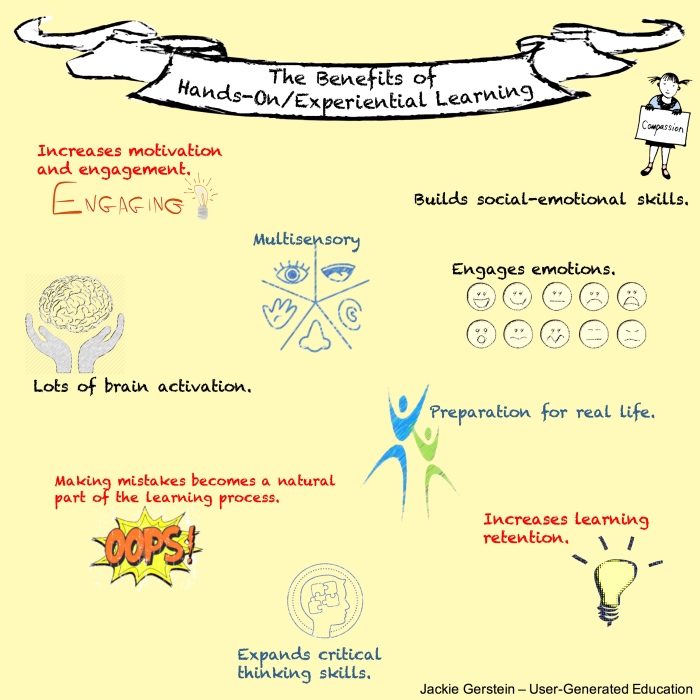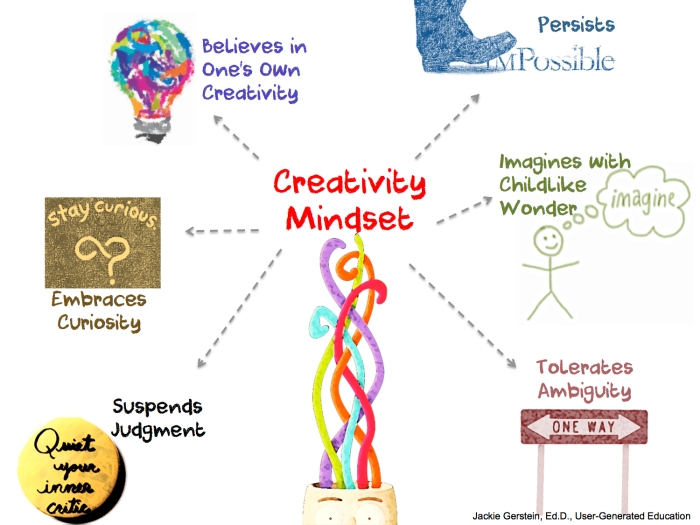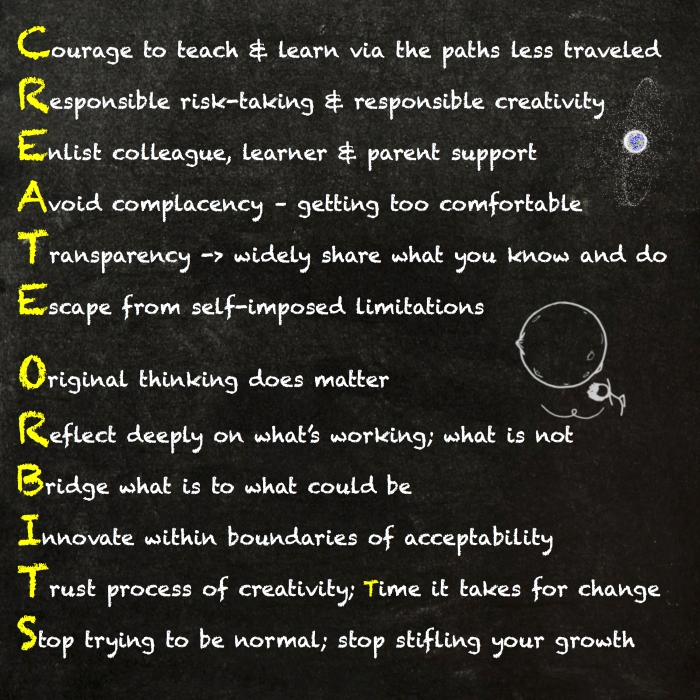Posts Tagged ‘creativity’
Maker-Enhanced Writing Workshop: Character Development
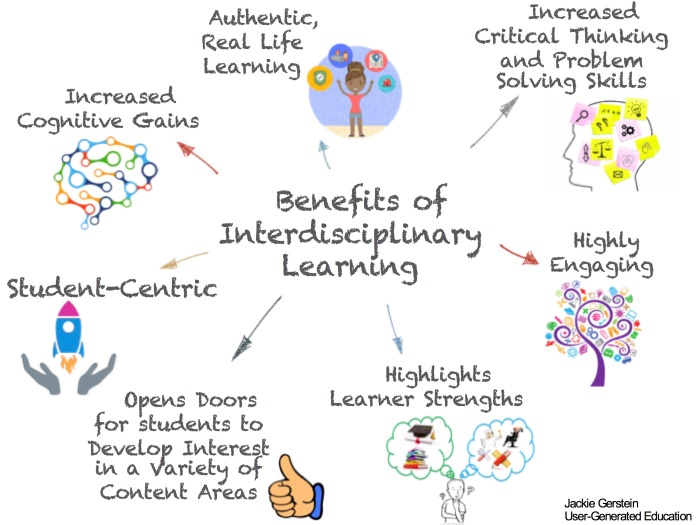
Readers of my blog know my thoughts and feelings about effective student learning. I have written blogs on:
- All Lesson Should Be Interdisciplinary Learning – https://usergeneratededucation.wordpress.com/2019/01/13/all-lessons-should-be-interdisciplinary/
- The Imperative of Experiential and Hands-On Learning –https://usergeneratededucation.wordpress.com/2016/12/23/the-imperative-of-experiential-and-hands-on-learning/
- Authentic Learning Experiences – https://usergeneratededucation.wordpress.com/2019/01/20/authentic-learning-experiences/
- Intentional Creativity – https://usergeneratededucation.wordpress.com/2017/08/20/intentional-creativity/
- The Magic of Making: The Human Need to Create –https://usergeneratededucation.wordpress.com/2018/03/04/the-magic-of-making-the-human-need-to-create/
This month I started a maker-enhanced writing workshop with a group of gifted 3rd through 6th grade students. As with all of my lessons, I strive to practice what I preach in my blog posts – being interdisciplinary; using technology to enhance their work; and making, creating, innovating, and inventing.
Standards Addressed
21st Century Skills
- Elaborate, refine, analyze and evaluate their own ideas in order to improve and maximize creative efforts.
- Create new and worthwhile ideas (both incremental and radical concepts).
- Elaborate, refine, analyze and evaluate their own ideas in order to improve and maximize creative efforts.
- Develop, implement and communicate new ideas to others effectively.
- Articulate thoughts and ideas effectively using oral, written and nonverbal communication skills in a variety of forms and contexts.
Next Generation Science Standards
- Define a simple design problem reflecting a need or a want that includes specified criteria for success and constraints on materials, time, or cost.
- Evaluate competing design solutions using a systematic process to determine how well they meet the criteria and constraints of the problem.
Common Core State Standards – ELA
- Write narratives to develop real or imagined experiences or events using effective technique, relevant descriptive details, and well-structured event sequences.
National Core Arts Standards
- Students will generate and conceptualize artistic ideas and work.
ISTE Standards for Students
- Students use a variety of technologies within a design process to identify and solve problems by creating new, useful or imaginative solutions.
National Novel Writer’s Month Young Novelist’s Workbook
For this project, I use parts of the National Novel Writer’s Month Young Novelist’s Workbook found at https://ywp.nanowrimo.org/pages/educator-resources.
National Novel Writing Month (NaNoWriMo) is a fun, empowering approach to creative writing. The Young Writers Program (YWP) allows 17-and-under participants to set reasonable-but-challenging individual word-count goals.
The YWP also helps K–12 educators facilitate NaNoWriMo in schools, libraries, and community centers around the world. We provide virtual classroom spaces on our site, as well as student workbooks, Common Core-aligned curricula, and free motivational materials (https://ywp.nanowrimo.org/).
Since I work with 3rd through 6th graders, I use the one for elementary students. I also like the way it is formatted with lots of places to insert one’s own answers and ideas. Here is the PDF – elementary_school_workbook_ed4_INTERIOR.
Character Development
After some introductory information, the workbook jumps into character develop. I like having my learners begin by developing their characters. They did so by:
- Describing their character (pages 11 – 25 in the workbook).
- Drawing a picture of their characters.
- Creating a more artistic version of their character using additional art materials.
- Posting a description and image of their character onto Kidblog.
- Using Scratch and Makey Makey to describe the main characteristics of their characters.
Example Character Description and Artistic Creation
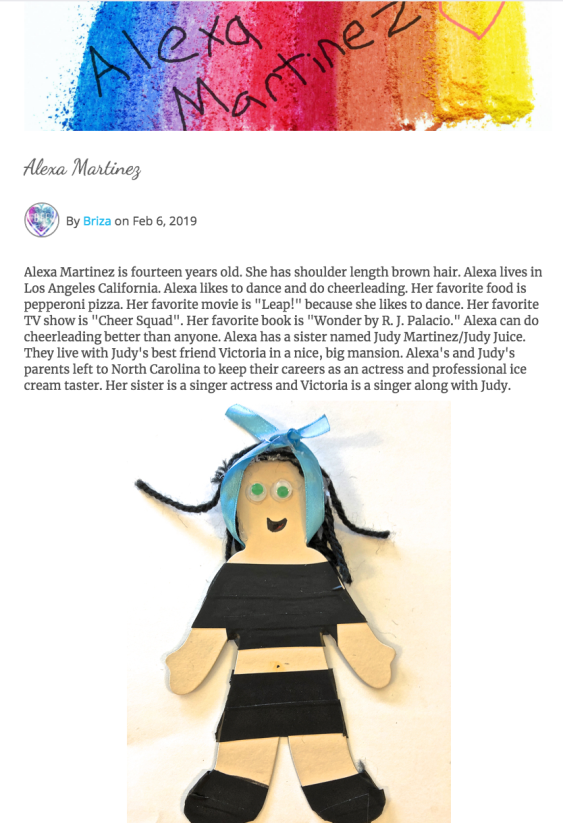
Programming Character Details Using Scratch and Makey Makey
The idea for this part of the lesson came from the Makey Makey Biography Bottles https://labz.makeymakey.com/cwists/preview/1506-biography-bottlesx. In the case of their character development, students programmed Scratch to tell a fact about their character upon the touch of each button.
The first step is to create the physical element, the character is glued onto a piece of cardstock (file folders work well for this). Holes are punched along the bottom – five for five facts and one for the Makey Makey ground wire. Large brass fasteners are inserted so that one of the fastener legs is bent to hold it in place and the other hangs over the edge. This permits the connection between the object and the Makey Makey.

Students then program Scratch so that when different fasteners are touched, a different fact about that character is verbalized. Scratch 3.0 now has extensions for Makey Makey and Text to Speech – both which are used for this project.
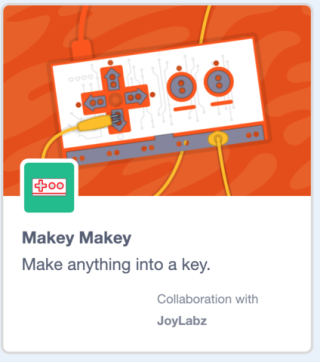
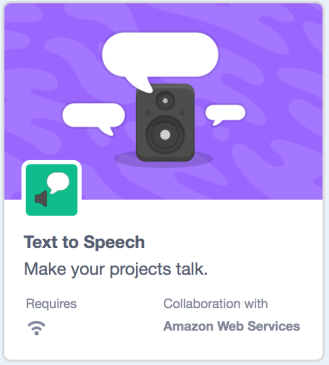
They upload a picture of their character and choose five facts about their character – one fact for each of the Makey Makey keys – space, up arrow, down arrow, left arrow, and right arrow. These facts are made via Text to Speech blocks. Students can even change accents and languages with these blocks.
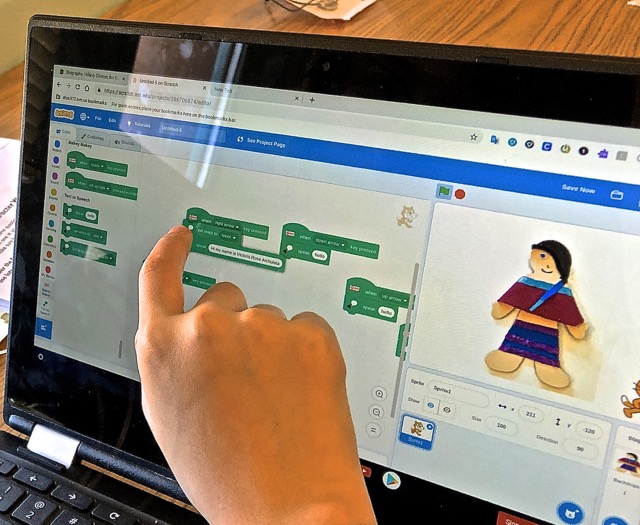
Now you are ready to connect the Makey Makey! Connect alligator clips to the legs of the brass fasteners that protrude from the conductive plate. It is a good idea to mark which button you want to trigger each key press. Connect the other end of each alligator clip to the matching input on the Makey Makey. Make sure you have a clip attached to the ground. Connect the Makey Makey to the computer. Run your Scratch program. Hold the ground clip (making sure you are touching the metal part) and lightly touch each button (https://www.instructables.com/Biography-Bottles/ ).
To see how it all works, watch the video below:
Day of the Dead (Dia de los Muertos) Displays: A Maker Education Project
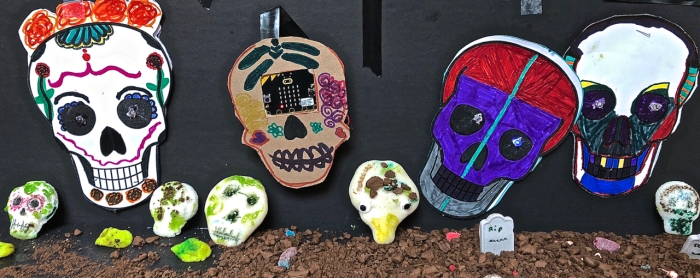
I have lived in Santa Fe, New Mexico for a few decades. One of my favorite things about living here is that my town celebrates and embraces Hispanic and Mexican cultural traditions. I have the privilege of working with gifted kids at two elementary schools with over 80% Hispanic students. For the past two years, I did Halloween Wars – based off of the Food Channel show. See Halloween Wars: An Interdisciplinary Lesson with a STEM, STEAM, Maker Education Focus for more about this. Because of the cultural heritage of my students and because I find the Day of the Dead holiday so intriguing and beautiful (the movie, Coco, helped bring its beauty to the masses), I decided to focus on having the students create Dia de los Muertos displays this year.
Standards Addressed
21st Century Skills
- Using 21st century skills to understand and address global issues
- Learning from and working collaboratively with individuals representing diverse cultures, religions and lifestyles in a spirit of mutual respect and open dialogue in personal, work and community contexts
- Understanding other nations and cultures, including the use of non-English languages
- Create new and worthwhile ideas (both incremental and radical concepts)
- Elaborate, refine, analyze and evaluate their own ideas in order to improve and maximize creative efforts
- Create new and worthwhile ideas (both incremental and radical concepts)
- Elaborate, refine, analyze and evaluate their own ideas in order to improve and maximize creative efforts
Next Generation Science Standards
- Define a simple design problem reflecting a need or a want that includes specified criteria for success and constraints on materials, time, or cost.
- Evaluate competing design solutions using a systematic process to determine how well they meet the criteria and constraints of the problem.
- Analyze and interpret data on the properties of substances before and after the substances interact to determine if a chemical reaction has occurred.
Common Core State Standards – ELA
- Write narratives to develop real or imagined experiences or events using effective technique, relevant descriptive details, and well-structured event sequences.
Getting Started – Gaining Attention
To introduce and show students the traditions related to Day of the Dead, they are shown the following videos:
-
Day of the Dead- Flavor and Tradition – https://www.youtube.com/watch?v=rdlL45ljkEY
-
What is Day of the Dead? | National Geographic – https://youtu.be/_sSawpU81cI
-
Dia de los Muertos (short film) – https://youtu.be/-v4-1wFEzM0
. . . as well as given time to explore the Smithsonian Latino Center’s Theater of the Dead – http://latino.si.edu/dayofthedead/ which includes an interactive element to build their own alter or Ofrenda.
Writing a Story About Day of the Dead
Students write a story with a Day of the Dead theme. They are given the option to write it alone or with a partner. Here is an example from one of my 6th grade students:
Artifacts for the Day of the Dead Displays
Students make the following artifacts and then, in small groups of three students, decide if and how they want to use them in their Day of the Dead displays to reflect the stories they wrote.
Decorated Skulls with Paper Circuits for Eyes
Materials: skull outline and parallel circuit outline (one for each student), 5MM LED lights, copper tape, coin batteries, transparent tape, markers.
Students decorate their paper skulls and then make parallel paper circuits to light up the eyes of these skulls. I found a template of a skeleton skull online. I printed these out – one for each student. I then made an outline of a parallel circuit so that when connected and joined with the top part, the LEDs would show up as pupils of the decorated skull – see below.
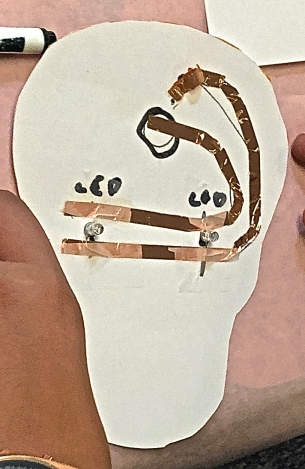

Students first cut out and decorate their skulls with markers. Images of decorated Day of the Dead skulls can be projected via a whiteboard so students can see examples. They then trace their cut out skulls onto the paper circuits template and cut that out. The bottom piece, containing the parallel circuit design, is then wired with the copper tape. The shorter copper tape is taped down from the battery placeholder to the end of its outline, so that the coin battery can be placed on top of that. For the longer piece of copper tape, about 1.5 inches is left at the end near the battery. This extra is folded onto itself so that after the battery is in place, this part of the copper tape can be taped on top of the battery. Having a folded over end piece makes it more manageable. Students should be reminded how to find the polarities of both the LEDs (the longer leg is positive) and the coin battery (it has a + on the top – that side with a little bit larger diameter). Students then tape their batteries and LEDs in place insuring that the positive legs of the LED lead to positive side of the battery and visa-versa. For more about paper circuits, see https://www.makerspaces.com/paper-circuits/. The LEDs are then poked through the eyes of the decorated skull. The top and bottom pieces are then stapled together.
Sugar Skulls
Materials: sugar, meringue powder, sugar skull molds
Sugar skull molds can be purchased from https://www.mexicansugarskull.com/sugar_skulls/sugar-skull-molds.html. Sugar skulls are incredibly easy to make – just combining the dry ingredients of sugar and meringue power and adding a little water so it becomes the consistency of dampened beach sand. More directions along with amounts can be found at https://www.mexicansugarskull.com/sugar_skulls/instructions.html. After waiting at least 24 hours for the skulls to harden, students can then decorate them using edible markers or royal icing.
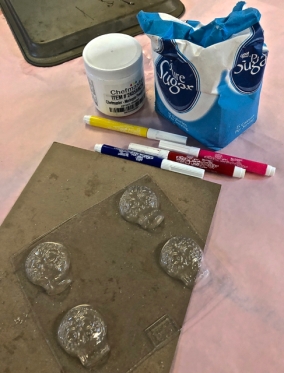
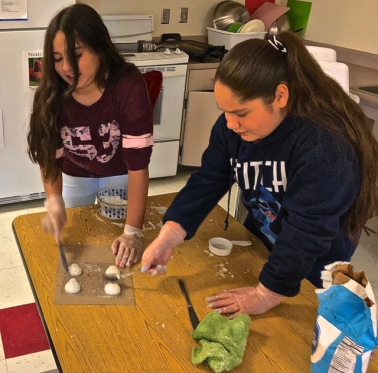
Skulls from Modeling Chocolate
Materials: white chocolate morsels, corn syrup.
This is another easy recipe to make (see http://artisancakecompany.com/recipe/how-to-make-perfect-modeling-chocolate/ for specific directions) although it is a bit tricky to get the modeling chocolate to the right consistency. Once the modeling chocolate is made, students sculpt it into 3D skulls.


micro:bit Lit Skull
Materials: micro:bit (one for each team), heavy stock cardboard, (servos with jumper wires and alligator clips if movement is designed)
A micro:bit is mini-computer, half the size of a credit card equipped with 25 red LED lights that can flash messages. The micro:bit features an embedded compass, accelerometer, mobile, and web-based programming capabilities. It is compatible with a number of online code editors across a number of different languages (https://learn.sparkfun.com/tutorials/getting-started-with-the-microbit). For this activity, students cut out a skull with a window in the middle for the micro:bit (see below). They then use https://makecode.microbit.org/ to (1) create a message on the LEDs about Day of the Dead, and (2) code the servo to rotate the skull in a small arc from side to side (see https://sites.google.com/view/microbitofthings/7-motor-control/11-servo-control?authuser=0 for how to do this).


Tissue Paper Marigolds


Materials: yellow tissue paper, pipe cleaners.
The directions for how to make these can be found at https://tinkerlab.com/simple-paper-marigolds-dia-de-los-muertos/,
Edible Slime
Materials: sugar free Jello, starch
This is an easy recipe with the slime made by combining sugar free Jello, food starch, and water. Colors are determined by the flavor of the Jello – I like using lime for green slime and strawberry for red slime. For more information, visit https://thesoccermomblog.com/edible-silly-putty/
Miscellaneous Materials
Students are provided with core board and also given candy bones, candy gravestones, and chocolate animal crackers (to be crushed into dirt) so that these items along with the projects described above can be used for their displays, again reminding students that the displays should directly reflect their stories about Dead of the Day – Dia de los Muertos.
Student Reflection
Students were asked to randomly choose five cards from the deck of my Maker Reflection Cards to reflect on their experiences with this project. They were told that they could discard two of them but would need to answer three of them via a blog post, and I was totally elated when one asked if he could answer more – seven of them! Here are screenshots of his and another student’s reflections.

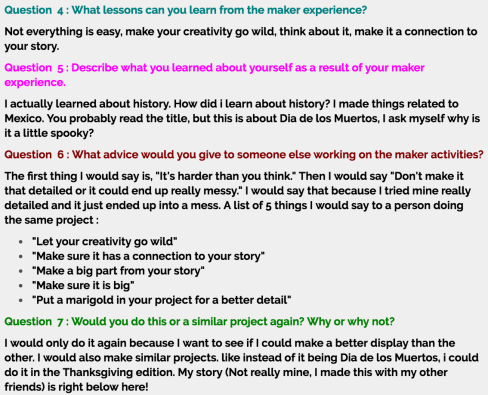
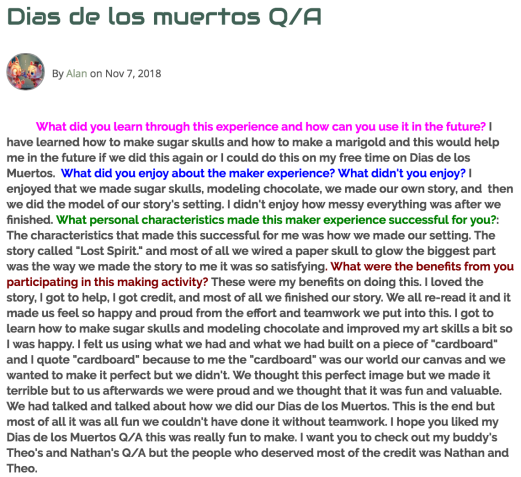
Choice + Imagination = Fantastic Results
Destination Imagination (DI) has been recommended by my supervisor for use with gifted students. I teach gifted students at two Title 1 elementary schools.
DI MISSION
To engage participants in project-based challenges that are designed to build confidence and develop extraordinary creativity, critical thinking, communication, and teamwork skills
DI PRINCIPLES
- Fun learning: Explore STEM/STEAM concepts in a hands-on environment
- Creative problem solving: Learn how to think, not what to think
- Kid powered; team driven: Energize students to own all decisions, creations, and results
- Friendly competition: Motivate teams to reach for the stars, while also rooting for each other
- Global diversity: Encourage and celebrate differences in each other, and differences in ideas.
(https://www.destinationimagination.org/vision-mission/)
Destination Imagination has developed Instant Challenges to help spark student creativity. Recently, I had one class of gifted 6th graders do the Fortune Teller Instant Challenge. See below.

Here is a PDF that leads to the several versions of the Destination Imagination Fortune Teller: Destination_Imagination_IC_Makers PDF
I only have four students in this particular class and interestingly, each selected a different project:
- Tell a Story About Being Very, Very Hungry at a Concert
- Make a Cartoon About Getting a New Pet in a Fishbowl
- Create a Song About Trying to Fly at an Amusement Park
- Create a Commercial About Trying to Fly at an Amusement Park
They (except for the cartoon) recorded their projects in front a green screen and then added background images using iMovie. Here are their finished creations:
They had 100% engagement throughout the project. This is significant as two of the girls sometimes have a difficult time getting and staying focused on their projects during class. I believe this occurred because they were given a choice and they had to use their imaginations.
Choice
I have blogged about giving student voice and choice in the past.
Education works when people have opportunities to find and develop unaccessed or unknown voices and skills. Audre Lorde poignantly describes this “transformation of silence into language and action [as] an act of self-revelation.” Opportunities for flexibility and choice assist learners in finding passion, voice, and revelation through their work. (http://www.edutopia.org/blog/student-choice-leads-to-voice-joshua-block)
Internet accessibility, technologies that permit the user-generated media, and social media allow for unlimited potential for learner choice and voice.
Learner Choice can be facilitated through:
- Giving learners choice in how they want to learn content including through videos, text-based resources, podcasts, hands-on modules, or human interactions (see UDL’s multiple means of representation).
- Giving learners choices to show what they know-what they learned through anything from writing a paper to creating a multimedia presentation to creating a performance art work (see UDL’s multiple means of action and expression).
- Giving learners choice to study topics based on personal interests as it facilitates natural engagement in learning (see Interest Fuels Effortless Engagement).
- Being a tour guide of learning possibilities – show learners the possibilities and then get out of the way (see https://usergeneratededucation.wordpress.com/2015/07/26/show-learners-the-possibilities-and-then-get-out-of-the-way/).
Imagination
I believe that most of student learning should contain some form of them using their imaginations. Sadly, though as Sir Ken Robinson noted over ten years ago, “schools are killing creativity.”
According to research conducted by Kyung Hee Kim, Professor of Education at the College of William and Mary, all aspects of student creativity at the K-12 level have been in significant decline for the last few decades. Based on scores from the Torrance Tests of Creative Thinking, her study reveals “that children have become less emotionally expressive, less energetic, less talkative and verbally expressive, less humorous, less imaginative, less unconventional, less lively and passionate, less perceptive, less apt to connect seemingly irrelevant things, less synthesizing, and less likely to see things from a different angle” (How America’s Education Model Kills Creativity and Entrepreneurship).
From my blog post, Intentional Creativity:
Embedding creativity into the curriculum can and should be a strong component of content area teaching and learning. In other words, educators don’t need to plan to teach creativity as another part of curriculum. Creativity is often an integral part of the practices of professionals including scientists, mathematicians, business people, artists, writers, and is an important part of their content area expertise. It follow, then, that learners should be taught in ways that help them think like a scientist . . . like an artist . . . like a writer . . . like a business person.
Scaffolding Maker Education Learning Experiences
I often read via social media about the importance of student centered, student-driven instruction. I wholeheartedly agree. My blog post is called User-Generated Education for a reason. I also believe one of the roles of an educator, in the context of maker education, is to scaffold learning experiences so the end result is students becoming self-determined learning.
Thinking about the importance of learner autonomy and independence reminded me of my early career when I did counseling work with at-risk youth in wilderness settings, taking them on 2 to 3 week wilderness trips. We did what was called Huddle-Up Circles. Huddle-ups were called by the instructors and/or the youth participants any time a concern or problem arose. Everyone stopped what they were doing to gather in a circle to discuss the problem and generate solutions. Needless to say, the instructors were the ones who most often called and facilitated the huddle-ups at beginning of our trips. Our goal, as instructors and counselors, was to have the young people run the huddle-ups themselves. We knew we were successful when we asked to step out of the huddle-ups by the young people because they wanted to run their own huddle-ups. During these times, we would stand outside of the huddle-up circles and silently observe their processes, only stepping in upon their request. The results not only included the development of skills and strategies for their own social-emotional development, but their success with their earned independence boosted their self-esteems.
This is how I approach facilitating maker education activities. Direct instruction is provided through structured and prescribed activities with the goal of learners then being able to eventually go into self-determined directions. There has been some criticism leveraged against out-of-the-box maker education kits, programmable robots, and step-by-step maker activities. My contention is that learners often don’t know what they don’t know; and that giving them the basic skills frees them to then use their creativity and innovation to take these tools into self-determined directions.
In response, I created and proposed Stages of Maker Education:
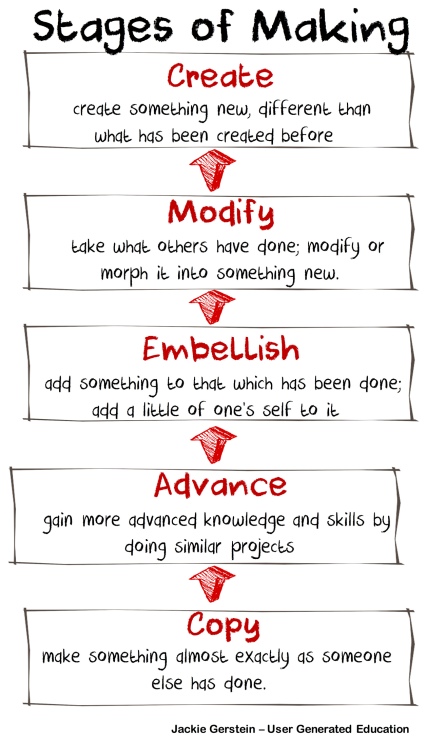
In my robotics and coding classes, I use Ozobot, Spheros, Dash and Dot, microbits, Scratch, to name of few. I use a full spectrum of activities starting with direct instruction associated with the Copying stage, then assisting learners to move through the Advance, Modify, and Embellish stages by providing them with examples and resources, and finally, encouraging them to move into the Create stage. Sometimes I show them examples of possibilities for the Create stage. I show such examples to spark and ignite their creative juices. Because almost all of my learners have not had the freedom to create, these examples help to get them motivated and going. Here some are examples of two ends of the spectrum – Prescribed/Copy and Create – of some of these robotic and coding activities to show how learning basic skills can lead to creative activities:
- Ozobot:
- Prescribed/Copy – Ozobot Basic Training
- Create – for creative use of Ozobot examples see https://youtu.be/2C-jbsfBJvA and https://youtu.be/OtUXrVGW3r0 (One of my groups of gifted students are currently working on their own projects to tell a story with Ozobot. I will add their stories once they are completed.)
- Dash and Dot:
- Prescribed/Copy – Teacher-driven lessons found at https://education.makewonder.com/curriculum/learn-to-code
- Create -for examples of the creative use of Dash, see Creativity Corner found at https://www.makewonder.com/play/ideas/
- Scratch:
- Prescribed/Copy – Using Scratch Cards and/or doing Scratch Starter Projects
- Create – for creative examples of Scratch, see https://scratch.mit.edu/studios/232765/
- Sphero:
- Prescribed/Copy – beginning coding activities found at https://edu.sphero.com/cwists/category
- Create – for ways that Sphero creatively for cross-curricular activities, see http://stemeducationguide.com/classroom-activities-sphero/
- micro:bit:
- Prescribed/Copy – step-by-step projects found at https://makecode.microbit.org/# and https://makecode.microbit.org/projects
- Create – for examples of creative projects using micro:bits, see http://microbit.org/en/2017-04-12-mothers-challenge-winners/
My ultimate goal is to have students drive their own learning and I want to help them learn skills to be successful in their self-determined learning.
Specific Ideas for Intentional Creativity
Recently I wrote a blog post about Intentional Creativity. Here is the graphic created for that post. Below the graphic are specific ideas I am using with my gifted elementary students this school year.

What follows are the activities I am using this school year to be intentional with sparking creativity in my gifted education classrooms. The titles are links for these activities.
Destination Imagination Instant Challenges

Goal: To spark creative divergent thinking for STEM, STEAM, and science based learning.
Description: Instant Challenges are fun, STEAM-based group activities that must be solved within a short period of time. Using your imagination, teamwork and few everyday materials, you and your friends will work together to see just how innovative you can be. With hundreds of potential combinations and ways to solve each Instant Challenge, the creative possibilities are endless!


Write About
Goal: To get learners’ primed to do some creative writing.
Description: Don’t look at Write About as another thing to add. It’s a platform for writing and a community for publishing writing…regardless of the genre, purpose, length or audience. We believe a balance between digital and physical is a healthy thing, and support your pencil/paper writer’s notebooks whole heartedly! But when you want students to transition their writing skills into a digital space…when you want to empower them with choice and visual inspiration for creative sparks…when you want them to have an authentic audience for their writing…when you want them to leverage multi modal tools like audio and images…that’s where we come in!
Minute Mysteries
Goal: To help learners to think outside of the box; to develop alternative perspectives of perceived reality.
Description: Minute mysteries are riddles where students ask yes or no questions to try and solve the riddle. They are called minute mysteries because they are usually a bit more complex than your average riddle.
Rebus Puzzles
Goal: To help learners playful interact with the symbolic nature of language.
Description: Rebus Puzzles are essentially little pictures or riddles, often made with letters and words, which cryptically represent a word, phrase, or saying.
Classroom Icebreakers
Goal: To build community; help create a classroom climate with a sense of fun and whimsy.
Description: Useful for the beginning of a class period or toward the beginning of a semester when students don’t know each other well, Introduction and Breaking-the-Ice games can dramatically transform the dynamics of your classroom. More ideas can be found at: https://www.pinterest.com/explore/classroom-icebreakers/
Intentional Creativity
Torrence, whose focus was on creativity, developed the Torrence Incubation Model of Creative Thinking (TIM) model.
As emphasized in this video, embedding creativity into the curriculum can and should be a strong component of content area teaching and learning. In other words, educators don’t need to plan to teach creativity as another part of curriculum. Creativity is often an integral part of the practices of professionals including scientists, mathematicians, business people, artists, writers, and is an important part of their content area expertise. It follow, then, that learners should be taught in ways that help them think like a scientist . . . like an artist . . . like a writer . . . like a business person.
E. Paul Torrance, perhaps one of the most prominent scholars of creativity, conducted a variety of studies exploring the teaching and learning of creativity. His studies identified specific skills associated with creativity, and demonstrated success in the teaching of creativity through the Torrance Incubation Model of Creative Teaching and Learning. The Torrance Incubation Model of Creative Teaching and Learning can be applied to a lesson, unit or project. The application of TIM and the identification of a specific creativity skill is an effective way to teach creativity, without impacting the teaching of core objectives or curriculum content. TIM, has three stages: Stage One, Heighten Anticipation, is designed to adequately and mentally prepare the student (or students) for the project ahead. Torrance describes this as a ʻWarming Up Periodʼ with the following six functions, (1) Create the Desire to Know, (2) Heighten Anticipation and Expectation, (3) Get Attention, (4) Arouse Curiosity, (5) Tickle the Imagination, and (6) Give Purpose and Motivation. (Torrance Incubation Model of Creative Teaching and Learning (TIM))
Specific active methods for heightening anticipation include:
- Using an ice-breaker – examples can be found at http://smartstorming.com/downloads/SmartStorming_25%20Great_Icebreakers.pdf
- Showing an engaging video and then having a discussion about it.
- Telling a story, using comics or humor. (For more about the use of stories, see Storytelling Is Not Lecturing; Lecturing is Not Storytelling).
- Presenting a challenge or problem.
- Using an online tool like Padlet or Flipgrid to propose open-ended questions.
- Doing a non-graded group quiz with a tool such as Kahoot or Quzziz
- Having learners play an analog or video game; or online interactive. For STEM examples, see http://www.pearltrees.com/jackiegerstein/online-stem-interactives/id18098228.
The benefits of educators being intentional with heightening anticipation include:
- Increased engagement in and motivation for the learning activities.
- Increased interest in content area learning; possibly stimulating new learner passions.
- Deeper learning.
- More generalizable skills related to creativity.
So just with a little planning, the educator can set up conditions that can significantly motivate learners and create an energized learning environment climate.

Cardboard Creations: A Maker Education Camp
This post discusses my Cardboard Creations Maker Education Camp that was taught to fifteen 5 to 12 year old learners for five days, 2.5 hours each morning during Summer, 2017. It is split into three sections:
- Rationale for Using No Tech, Minimal Cost Materials
- Some Pedagogical Perspectives
- Summer Maker Education Camp Project
Rationale for Using No Tech, Minimal Cost Materials
Cardboard Creations Maker Education Camp utilized no technology (except for projecting images of example projects on the whiteboard) and low/no cost materials. Many of the discussions about and actions related to integrating maker education into educational environments center around the use of new technologies such computer components (Raspberry Pis, Arduinos), interactive robots for kids (Dash and Dot, Ozobots, Spheros), and 3D printers. These technologies are lots of fun and I facilitate Robotics and Computer Science with my gifted students and at one of my summer camps. The learners engaged in these high tech learning activities with high excitement and motivation. Such high excitement, engagement and motivation, though, were also seen at my low tech/low cost maker education camps: LED crafts, Toy Hacking and Making, and Cardboard Creations.
As a recent NPR article discussed several challenges for maker education. One of them was related to equity issues, providing maker education for all students regardless of income level:
A big challenge for maker education: making it not just the purview mostly of middle- and upper-middle-class white kids and white teachers whose schools can afford laser cutters, drones or 3-D printers (3 Challenges As Hands-On, DIY Culture Moves Into Schools).
In order to adequately address this challenge, it becomes important to speak of making in broader terms; that maker education is so much more than 3D printing, drones, and robots. As Adam Savage from Mythbusters notes:
What is making? It is a term for an old thing, it is a new term for an old thing. Let me be really clear, making is not simply 3D printing, Art Lino, Raspberry Pi, LEDs, robots, laser and vinyl cutters. It’s not simply carpentry and welding and sculpting and duct tape and drones. Making is also writing and dance and filmmaking and singing and photography and cosplay. Every single time you make something from you that didn’t exist in the world, you are making. Making is important; it’s empowering. It is invigorating (Adam Savage’s 2016 Bay Area Maker Faire Talk).
Doing and promoting maker experiences such as cardboard projects have the potential to offset the challenges associated with access and costs as well as provide opportunities for making by all.
Cardboard, my makerspace material of choice, is available in every home in America. From mac and cheese boxes to a shoebox, cardboard is a material that puts students on a level playing field. It’s free. Students can cut thin stuff with scissors or score corrugated material with a pair of safety scissors, and tape is cheap enough that I can send a partial roll home with a student who needs it. Kids in families who cannot afford clay or craft kits or have little money for additional classroom supplies can still imagine something using materials that belong to them. That equals the playing field among students who ‘have not’ with students who ‘have’ adequate resources (Cardboard Creators: Reusing to Learn).
Some Pedagogical Perspectives
The Experiential Nature of Maker Activities Makes Them Messy, Loud, and Chaotic
Traditional classrooms are often marked by students quietly at their desks completing the same tasks at the same time. This is opposite of what went on during the Cardboard Creations Maker Education camp. The classroom was loud, seemingly chaotic and messy. Cutting and working with cardboard creates a mess, but authentic and engaged learning is often messy.
Learning is often a messy business. “Messy” learning is part trial and error, part waiting and waiting for something to happen, part excitement in discovery, part trying things in a very controlled, very step by step fashion, part trying anything you can think of no matter how preposterous it might seem, part excruciating frustration and part the most fun you’ll ever have. Time can seem to stand still – or seem to go by in a flash. It is not unusual at all for messy learning to be …um …messy! But the best part of messy learning is that besides staining your clothes, or the carpet, or the classroom sink in ways that are very difficult to get out … it is also difficult to get out of your memory! (http://www.learningismessy.com/quotes/)
Concepts and Skills Naturally Embedded in a Context
Concepts and skills became embedded in the experiential activities. Learning of concepts and skills occurred at the time when the campers’ interest and need were the highest. For example, when the learners did their solar ovens, several concepts were introduced and talked about: direction of sun rays, solar energy, angle of lean. These discussions and knowledge helped them to better their design and set up their solar ovens. Their learning had a context and a reason.
The same was true for the the learning of skills. Learners were motivated and attentive when I demonstrated certain cardboard folding and connecting techniques. This also included soft skills such as communicating needs, asking for what they needed, and collaborating with others as they found a genuine need and desire to use them.
The Cardboard Box as a Blank Palette
Many of kids’ toys are promoted and sold with directions, solutions to problems, and expectations for end products.
Unfortunately for kids today, the designed world doesn’t leave much room for them to explore. Most toys come with pre-defined identities and stories, which rob children of the joy of imagining these things. This leaves few opportunities to figure out how to use a toy, experiment, fail, and invent the story of where it came from, and why it does what it does. Imagining, understanding, and becoming who we are is a process informed by play, and both toy companies and designers are taking all the exploration out of it (The Case For Letting Kids Design Their Own Play).
The cardboard box becomes a blank palette waiting for a kid’s imagination to make it into come alive especially in the mind of that kid. Making with cardboard doesn’t come with a set of step-by-step instructions about what and how to make. This is beautifully illustrated by the following short film.
Summer Maker Education Camp Projects
What follows are the projects that the campers did during the cardboard creation camp
Knight Costumes and Capture the Flag
The campers made shields, swords, helmets and then played Capture the Flag . I got this idea from http://www.instructables.com/id/Cardboard-Fortress-Battle-capture-the-flag/. Given the elementary age level, I cut out the shields and sword handles for them.
Solar Ovens for Smores
Campers made solar ovens for Smores which was an easy, high engagement cardboard activity for them to learn about and explore solar energy. There are lots of tutorials on the Internet about how to make these. Here is one of them: http://desertchica.com/diy-solar-oven-smores-kids-science-experiment/.
Photo Face-in-the-Hole
The materials for this activity were simply big pieces of cardboard and poster paints. Kids were given the task to make a photo face-in-the-hole. What they created can be viewed in the following slideshow.
Cardboard Box Foosball
Directions on how to make the cardboard box Foosball can be found at: http://www.muminthemadhouse.com/shoebox-table-football-foosball/. I cut the goal areas out for the campers ahead of time. They poked the holes for the dowels using the pointy end of the Makedo Safe-Saw.
Miniature Golf Course Holes
For this cardboard creation, I gave campers a long piece of card, a kid golf club and golf ball (bought at https://www.carnivalsource.com/store/p/194472-One-Set-Golf-Set/10-Pc.html) and had available toilet paper/paper towel rolls, pool noodles, small cardboard boxes for them to each make their own miniature golf course hole. When completed they were placed on the playground’s grassy area to make a miniature golf course.
Hot Wheel Car Tracks and Garages
For our last day, each camper was given a hot wheels car and told to create anything for that car using all of the left over boxes, duct tape, and Makedo screws. Most created tracks but a few created garages. This was equally engaging for the boys and for the girls.
Here is a link to my blog post that includes the cardboard challenge projects from summer, 2016: https://usergeneratededucation.wordpress.com/2016/07/25/cardboard-challenges-no-techlow-cost-maker-education/. My cardboard creations webpage of resources and project ideas can be found at http://www.makereducation.com/cardboard-challenge.html.
Creativity and Orbiting the Giant Hairball of School
Our creative genius is the fountainhead of originality. It fires our compulsion to evolve. It inspires us to challenge norms. Creative genius is about flying to new heights on untested wings. It is about the danger of crashing. It is amorphous, magical, unmeasurable and unpredictable…But we need our genius to bail ourselves out of the messes we continually get ourselves into. So, individually, we must override the cartel, set aside our herd longing for security through sameness and seek the help of our natural genius. Yours and mine. Orbiting the Giant Hairball
This post is a teaser for, a taste of a panel in which I am participating at The International Conference of Creativity, Thinking & Education in April, 2015 (please consider attending). The panel and this post focus on the idea of orbiting the giant hairball of education. Orbiting the Giant Hairball by Gordan MacKenzie is the inspiration for both the panel and this post. The theme revolves around how the systems of business and education often proclaim an affinity towards creativity of and by supervisors, employees, and stakeholders but in practice, actually stifle any actions that threaten the status quo. Growing Up and Out of Creativity in the System of School I believe one of the greatest ethical breaches of our school systems is training learners (and often educators) out of their love of learning and personal passions and creativity.
Our artificiality is caused, in part, by the many teachers who work so hard to instill a professionalism that prizes correctness over authenticity and originality. Flesh-and-blood students persevere the rigors of broadcast school only to emerge with voices as unreal as their pancake make-up. Budding designers, capable of passion, sweat the grind in schools of architecture and graduate to create environments unconnected to the lusciousness of life. Diamonds-in-the-rough enter business schools and come out the other end as so many polished clones addicted to the dehumanizing power of classification and systemization. Orbiting the Giant Hairball
The Giant Hairball of School
On the way to getting big, most companies [schools] turn into Giant Hairballs. Not on purpose; it just happens. Two hairs get tangled — not because they don’t work but because on some level, for someone, they work just fine. As it is joined by more and more hairs, each of which worked well enough somewhere for someone, the tangle becomes more complex and larger. Before you know it there’s a ball of hair so big it has it’s own gravity field strong enough to pull . . . almost anything . . . nearly anyone . . . into its mass. That force field is success. The Hairball prefers repeating established processes to the risks of innovation and creativity because repeating those processes works—every day until it stops working. A world honeycombed with established guidelines, techniques, methodologies, systems, and equations are at the heart of the hairball’s gravity. The trouble with corporate normalcy derives from and is dedicated to past realities and past successes. There is no room in the hairball of corporate normalcy for original thinking or primary creativity. Re-synthesizing past successes is the habit of the hairball. Orbiting the Giant Hairball
Many new educators enter the institution or system of education with high ideals, high energy and high creativity. In order to fit in, they work hard to conform to the guidelines, rules, and regulations; overt and covert; expressed and hidden, of that institution. Often, the result, sadly, is having their creativity sucked out of them – both as professional educators and as humans. They become victims of the giant hairball of institutionalized education.
Unfortunately, while the heart of Hallmark (and many schools) sings the virtues of creativity, the company’s intellect worships the predictability of the status quo and is, thus, adverse to new ideas. This incongruity creates a common corporate personality disorder: The organization officially lauds the generation of new ideas while covertly subverting the implementation of those same ideas. The consequence is that, on any given day, umpteen people at Hallmark, responding to official corporate invitation, come up with concepts for new methodologies or fresh, original products. Then those ideas, by nature of their newness, are deemed fundamentally unseemly by the same authority conglomerate that asked for them in the first place. This makes for a lot of frustrated ideamongers. Orbiting the Giant Hairball
Orbiting Around the System of School The purpose of this post, actually, is not to emphasize the dire straits schools are in regarding creativity. The purpose is to propose a call to action for educators to be creativity facilitators – to facilitate their own and their students’ natural propensity for creativity. To do so, they need to learn to orbit the giant hairball of school.
Orbiting is responsible creativity: vigorously exploring and operating beyond the Hairball of the corporate mindset, beyond “accepted models, patterns, or standards “—all the while remaining connected to the spirit of the corporate [school] mission. To find Orbit around a corporate Hairball is to find a place of balance where you benefit from the physical, intellectual and philosophical resources of the organization without becoming entombed in the bureaucracy of the institution. Remember, Hairballs don’t set out to become Hairballs. It is an unintended consequence. If you are interested (and it is not for everyone), you can achieve Orbit by finding the personal courage to be genuine and to take the best course of action to get the job done rather than following the pallid path of corporate appropriateness. Through this measured assertion of your own uniqueness, it is possible to establish a dynamic relationship with the Hairball — to Orbit around the institutional mass. If you do this, you make an asset of the gravity in that it becomes a force that keeps you from flying out into the overwhelming nothingness of deep space. Orbiting the Giant Hairball
The following acrostic-based poster, Create Orbits (informally titled An Educator’s Soul Survivor Kit), proposes strategies to assist educators who want to learn how to orbit the giant hairball of schools – to remain creative, excited, and energized (and assist learners to do the same) within acceptable boundaries of the school system.
Resources and Articles
- Schools are still killing creativity.
- Study Reveals Global Creativity Gap
- Inside the Box: People don’t actually like creativity
- Can Any School Foster Pure Creativity?
- What Kills Creativity?
- Educators argue creativity just as important as literacy and numeracy in national curriculum
As a parting shot – some creativity in education quotes:
